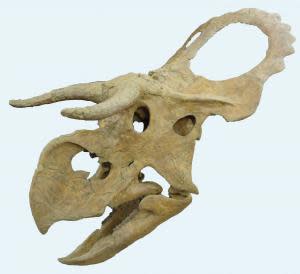Paleontologists Discover, Mock, New Dinosaur Species
Everybody stop what you're doing and grab your inner child: paleontologists have discovered what they're saying is a previously unknown breed of dinosaur in southern Utah. Meet the Nasutoceratops, whose name translates to what is more or less a playground insult: "big nosed horned face." It gets worse for our new friend: apparently, the big nose that seems to be his defining feature probably didn't help him smell. In fact, the researchers who identified the new species don't know what it's for at all. The study's lead author Scott Sampson said:
The jumbo-sized schnoz of Nasutoceratops likely had nothing to do with a heightened sense of smell—since olfactory receptors occur further back in the head, adjacent to the brain—and the function of this bizarre feature remains uncertain.
Leave Nasutoceratops alone. This Cretaceous period herbivore, likely a relative of the Triceratops, used the massive horns protruding from his skull (which many think resemble those of a cow's) to either attract females, or fight off rivals.
RELATED: BPA Exposure Just as Bad as Mercury; A New Big, Feathery Dinosaur
Sampson and his team are working in one of the last relatively unexplored expanses where dinosaurs, in the past, were known to be plentiful. He told National Geographic, who got an early look at the study, that what is now southern Utah was at one point the continent of Laramidia. Laramidia, likely the only home Nasutoceratops ever knew, was an isolated paradise, separated by a seaway from Appalachia, which comprised more or less the rest of the U.S. that wasn't underwater at the time. Sampson depicted Laramidia as a "gorgeous beachfront property, like wall-to-wall Jamaica," adding, "Just put up a few electric fences to keep out Tyrannosaurus and you'd be all set."
RELATED: The Oldest Dinosaur Embryo Ever Found Still Can't Make 'Jurassic Park' Real
Nasutoceratops would have fit right in on Laramidia: while the new discovery has some unusual features for a ceratopsid, most of its distant relatives looks pretty, well, distinctive, too. The new dino's closest relative, as far as the researchers can tell, is the Avaceratops.
RELATED: Nerds Howl as Lack of Funding Shuts Down SETI's Alien Search
Top Image: Handout, Natural History Museum of Utah.
RELATED: Natural History Museum Defends the Teen's Debunked Solar Discovery



